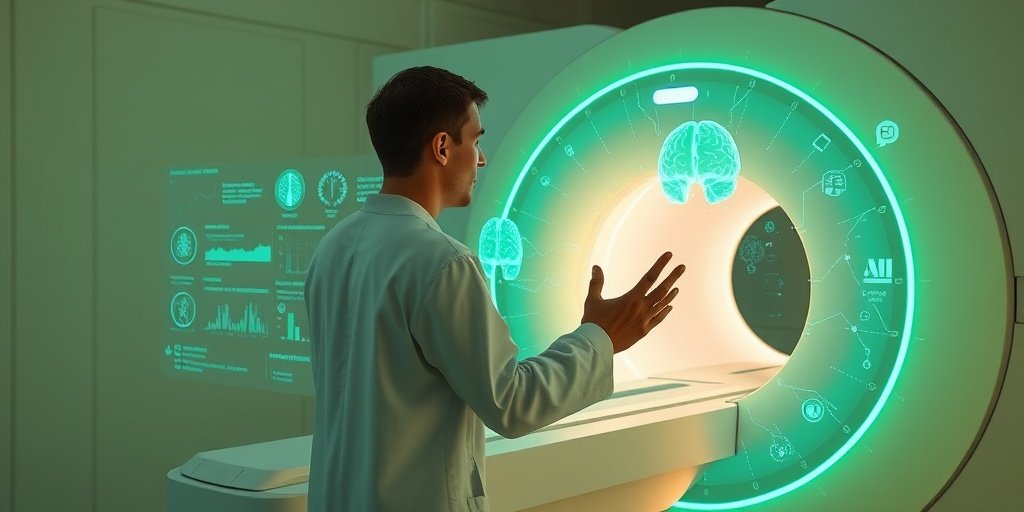⚡ Quick Summary
This study presents a voice-based interaction system for MRI scanners, utilizing large language models to enable hands-free control during clinical interventions. The system achieved a remarkable task completion rate of 93.3% in real MRI environments, demonstrating its potential to enhance operational efficiency and communication.
🔍 Key Details
- 📊 Tests conducted: 90 hands-free tests across 18 predefined tasks
- ⚙️ Technology used: Large language models for voice control
- 🏆 Performance: Overall task completion rate of 93.3% (95% CI 86.2-96.9%)
- ⌛ Response time: Approximately 5-10.5 seconds on a consumer laptop without GPU support
🔑 Key Takeaways
- 🗣️ Voice control allows for hands-free operation of MRI scanners, improving workflow.
- 🤖 Large language models facilitate natural language communication with the scanner.
- 🏥 Eliminates the need for additional assistants during MRI-guided interventions.
- 📈 High task completion rate indicates reliability and effectiveness of the system.
- 🌐 Study conducted in a real MRI scanning room, enhancing practical relevance.
- 💻 Operates on standard consumer hardware, making it accessible for various clinical settings.
- 🔄 Multi-agent collaboration enhances the system’s functionality and responsiveness.

📚 Background
In the realm of clinical MRI-guided interventions, the need for real-time control of MRI scanners is paramount. Traditionally, this has required the presence of an assistant, which can complicate workflows and introduce delays. The integration of advanced technologies, such as large language models, offers a promising solution to streamline these processes and enhance communication during procedures.
🗒️ Study
The study aimed to explore the feasibility of a voice-based interaction system for MRI scanners, leveraging large language models to facilitate hands-free control. Conducted in a real MRI scanning room, the researchers performed 90 hands-free tests involving 18 predefined tasks, assessing the system’s performance and reliability in a clinical setting.
📈 Results
The results were impressive, with the voice-based system achieving a task completion rate of 93.3%. This high level of performance, coupled with a response time of approximately 5-10.5 seconds, underscores the system’s potential to enhance operational efficiency in MRI-guided interventions. The confidence interval of 95% (86.2-96.9%) further validates the reliability of these findings.
🌍 Impact and Implications
The implications of this study are significant. By enabling hands-free control of MRI scanners, the proposed system not only improves workflow efficiency but also reduces the dependency on additional personnel during interventions. This advancement could lead to better patient outcomes and a more streamlined approach to MRI-guided procedures, ultimately enhancing the quality of care in clinical settings.
🔮 Conclusion
This study highlights the transformative potential of large language models in the field of medical imaging. By facilitating voice-based control of MRI scanners, we can expect to see improvements in operational efficiency and communication during interventions. As technology continues to evolve, further research and development in this area could pave the way for even more innovative solutions in healthcare.
💬 Your comments
What are your thoughts on this innovative approach to MRI scanner control? We would love to hear your insights! 💬 Share your comments below or connect with us on social media:
Proof of concept for voice based MRI scanner control using large language models in real time guided interventions.
Abstract
In clinical MRI-guided interventions, the lack of high-quality peripheral equipment and specialized interventional MRI systems often necessitates delegating real-time control of MRI scanners to an assistant. We proposed a voice-based interaction system powered by large language models that enabled hands-free natural language control of MRI scanners. The system leveraged multi-agent collaboration driven by large language models to execute scanner functionalities, including sequence execution, parameter adjustment, and scanner table positioning. In 90 hands-free tests for 18 predefined tasks performed within a real MRI scanning room, the system achieved an overall task completion rate of 93.3% (95% CI 86.2-96.9%). On a consumer laptop without GPU support, the response time for control commands was approximately 5-10.5 s. Our study demonstrates the feasibility of using large language models for voice-based interaction with MRI scanners during interventions, eliminating the need for additional assistants and allowing human-like communication.
Author: [‘Chen H’, ‘Gutt M’, ‘Belker OA’, ‘Düx DM’, ‘Wacker FK’, ‘Hensen B’, ‘Gutberlet M’]
Journal: Sci Rep
Citation: Chen H, et al. Proof of concept for voice based MRI scanner control using large language models in real time guided interventions. Proof of concept for voice based MRI scanner control using large language models in real time guided interventions. 2025; 15:31206. doi: 10.1038/s41598-025-11290-6